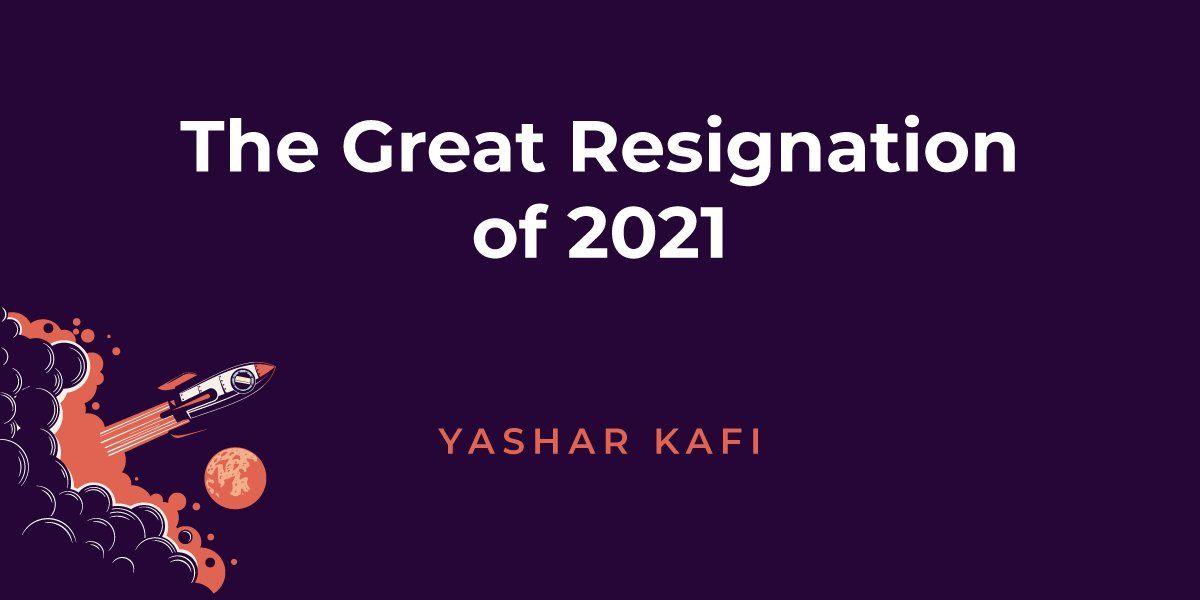The Great Resignation of 2021
We talk a lot about “The Greats.” And while most minds will immediately think of Tom Brady, Michael Jordan, or some other GOAT sports star, the “great” I am referring to is the Great Resignation.
What is the Great Resignation?
If you haven’t already heard about it, the Great Resignation of 2021 describes the current era of mass exodus—or more specifically, job switching—as a direct result of this past year’s pandemic-induced sheltering in place protocols. While this is a widespread resignation that has affected industries across the globe, certain niche areas have been impacted on a far greater scale, with companies in specific sectors posing a greater chance of losing employees.
The Great Resignation Industry Variance
Research shows that the computer and IT industries in particular and financial firms are the most likely to account for the lion’s share of job shifting. Forty-four percent from the IT and computer industry and 24% from financial firms have already changed jobs or are planning to do so soon (2022). Following fast on their heels at the top of the most affected industries list are the healthcare industry (18%) and food and hospitality industry employees.
Ready for even more statistics? Add to this the fact that 22% of survey respondents in America claimed to still be on the fence about whether or not they were jumping ship. You know what that means: Even more shifts could be on the horizon.
When such a massive exodus of employees arises, it is abundantly clear that something has to give. So, what went (is going) wrong here? Simply put: Employees have become unhappy with their current job situations for multiple reasons. Let’s break down a few of the top ones that are trending.
Employee Expectations
The bottom line is that employees’ expectations are no longer being met. What’s specifically topping the list of employee gripes? Lackluster compensation. I’m talking about money, and not enough of it! Half of the respondents surveyed revealed that seeking a situation with better pay and benefits was why they were looking to greener pastures.
Also, reasons for being ready to say good riddance and walking out the door? Exploring new career opportunities, particularly in the tech industry, where 70% mentioned wanting to strike out to start their own endeavors.
One big reason that has jumped to the forefront for many since remote working has been on the rise is the option of working from home versus physically coming into the office. These employees (43%) are opting to say goodbye to companies that aren’t on board with offering this more flexible option.
Unsurprisingly, this mass exodus of job shifters is leading to many companies facing major labor shortages.
The Great Resignation – What Can I Do?
So, as employers, this data may have you shaking in your boots (as it should). The good news is that there are proactive steps you can take to retain your employees.
A first step—listening to your employees—may seem obvious, but the real crux of the power in this approach lies in simultaneously giving them a real (and safe) platform to have their voices heard in the first place. Within this arena, you will be able to open up the dialogue and assess their contentment (or lack thereof) with the current culture and work situation. LISTENING, then addressing any areas of concern/contention that arise, is an excellent start.
Assessing—and addressing—your employees’ well-being will prove priceless in retaining your workforce. Some concrete actions that you can take to improve the overall well-being of your employees could include simple things like creative well-being initiatives, ensuring they have ample mental health resources at their disposal (like access to professional counseling or other ERGs), and more.
Finally, be open to evolving. This will undoubtedly mean being proactive in developing innovative and creative solutions for your employees’ changing expectations. Here is one example where the remote work issue must be addressed. Will a phased, hybrid approach to start be an olive branch of sorts that could work? Could you actually go completely remote and make it work?
Conclusion (or Just the Beginning?)
Let’s face it: These are unprecedented times, and we are all navigating uncharted waters here. However, the willingness to iterate and adapt moving forward will undoubtedly determine who sets sail toward new and exciting horizons or sinks.




